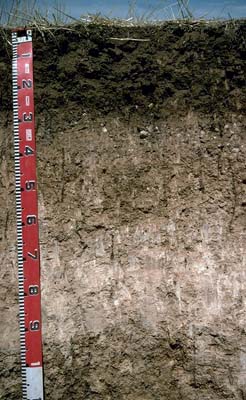LP49
| Property: LP49 | Australian Soil Classification: Endohypersodic, Pedal, Supracalcic CALCAROSOL |
| Northcote Factual Key: Gc 2.21 | Great Soil Group: no suitable group |
| General Landscape Description: Lower slope (almost flat) of a gently undulating rise within the Granite Highlands Landscape Unit. The original vegetation included Murray pine (Callitris columellaris), Buloke (Casuarina luehmannii) and Yellow Gum (Eucalyptus leucoxylon). | |
 LP49 Landscape |
Soil Profile Morphology
Surface Soil
| A11 | 0-5 cm | Dark brown (7.5YR3/4); clay loam (fine sandy); moderate fine granular structure; firm consistence dry; pH 7.4; clear change to: |  LP49 Profile |
| A12 | 5-20 cm | Dark brown (7.5YR3/4); clay loam (fine sandy) grading to light clay with depth; strong coarse blocky structure; strong consistence dry; pH 8.0; clear and wavy change to: | |
| Subsoil | |||
| B21 | 20-30 cm | Reddish brown (5YR4/4); light medium clay; moderate medium prismatic, parting to moderate coarse blocky structure; very firm consistence dry; pH 8.2; clear and wavy change to: | |
| B22k | 30-60 cm | Reddish yellow (5YR6/6); clay loam (fine sandy); weak prismatic structure; contains many (30%) hard calcareous nodules and (20%) fine-earth carbonates; firm consistence dry; pH 8.8; gradual change to: | |
| B23k | 60-90 cm | Reddish yellow (7.5YR6/6); light clay; weakly structured; contains very many (60%) fine-earth carbonates; very firm consistence dry; gradual and wavy change to: | |
| B24 | 90+ cm | Reddish yellow (7.5YR6/6); medium clay; strong coarse polyhedral structure; very firm consistence dry; pH 9.4. | |
NOTE: This site corresponds to the Type K soil as described by Skene (1971). | |||
Key Profile Features
- No major texture contrasts within the profile (i.e. gradational change).
- Calcareous throughout profile.
Key Profile Characteristics
pH | Salinity Rating | |||
Surface (A1 horizon) | slightly alkaline | medium | non-sodic | none1 |
Subsoil (B21 horizon) | moderately alkaline | low | non-sodic | none |
very strongly alkaline | high | strongly sodic | strong | |
| 1 Slight dispersion after remoulding | ||||
 |
Horizon | Horizon Depth | pH (water) | EC 1:5 | NaCl | Exchangeable Cations | |||
Ca | Mg | K | Na | |||||
meq/100g | ||||||||
A11 | 0-5 | 7.4 | 0.21 | 14 | 2.6 | 2.2 | 0.2 | |
A12 | 5-20 | 8 | 0.07 | 17 | 2.8 | 1.5 | 0.3 | |
B21 | 20-30 | 8.2 | 0.08 | 20 | 3.8 | 1.5 | 0.3 | |
B22K | 30-60 | 8.8 | 0.12 | 12 | 3.3 | 0.4 | 0.4 | |
B24 | 90+ | 9.4 | 0.95 | 0.13 | 3.7 | 10 | 1.2 | 7.4 |
Horizon | Horizon Depth | Ex Al mg/kg | Ex Ac meq/100g | Field pF2.5 | Wilting Point pF4.2 | Coarse Sand (0.2-2.0mm) | Fine Sand (0.02-0.2mm) | Silt (0.002-0.02mm) | Clay (<0.002mm) |
A11 | 0-5 | 25.4 | 17.3 | 15 | 33 | 12 | 35 | ||
A12 | 5-20 | 28.1 | 19.4 | 16 | 31 | 10 | 40 | ||
B21 | 20-30 | 33.4 | 23.9 | 14 | 25 | 8 | 50 | ||
B22K | 30-60 | ||||||||
B24 | 90+ |
Management Considerations:
- In general, management strategies for all soils should aim to increase organic matter levels in the surface soil; minimise the degradation of soil aggregates and porosity; promote the development of stable biopores; improve the calcium status of the ion exchange complex (particularly when sodium is a significant part), and break up any hardpans. Less frequent tillage; using less aggressive implements, and working the soil at optimum moisture conditions can all assist in maintaining soil aggregation and porosity as well as reducing the breakdown of organic matter.
Surface (A) Horizons
- The surface soil organic matter content and total nitrogen level is relatively high for a cropping soil. The overall nutrient status is also high.
- The relatively high wilting point value (17%) for the surface soil means that plants will not be able to fully utilise light rains falling on relatively dry soil as there will be insufficient moisture to wet the soil above the wilting point value.
- The surface horizons are relatively deep and well structured providing a suitable establishment and rooting environment for plants
Subsoil (B) Horizons
- The subsoil is very strongly alkaline from 30 cm depth. This indicates that phosphorus and some trace elements such as iron, manganese, zinc and copper may be poorly available to plants and deficiencies may occur. Deficiencies can be determined by plant tissue analysis. Boron toxicity can also occur in strongly alkaline soils.
- The upper subsoil is non-sodic and non-dispersive. It is therefore likely to present fewer limitations to rot and water movement into the subsoil compared to more sodic subsoils that occur in the region.
Landholder Comments:
- Lupins not grown successfully.
- Barley has been grown.
Notes:
Soil profile described by Mark Imhof, Paul Rampant and Karen de Plater (1/3/95)


